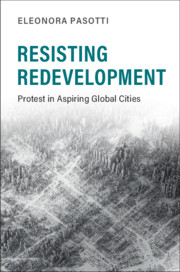Book contents
- Resisting Redevelopment
- Cambridge Studies in Contentious Politics
- Resisting Redevelopment
- Copyright page
- Dedication
- Contents
- Illustrations
- Acknowledgments
- Part I Setting the Comparison
- Part II Explaining Mobilization
- 5 Experiential Tools and Networks
- 6 Squatting, Experiential Tools, and Protest Legacies
- 7 Judicial Resistance, Experiential Tools, and Protest Legacies
- 8 Protest with High Union Support
- Part III Explaining Impact
- Book part
- Bibliography
- Index
- Cambridge Studies in Contentious Politics
7 - Judicial Resistance, Experiential Tools, and Protest Legacies
from Part II - Explaining Mobilization
Published online by Cambridge University Press: 09 March 2020
- Resisting Redevelopment
- Cambridge Studies in Contentious Politics
- Resisting Redevelopment
- Copyright page
- Dedication
- Contents
- Illustrations
- Acknowledgments
- Part I Setting the Comparison
- Part II Explaining Mobilization
- 5 Experiential Tools and Networks
- 6 Squatting, Experiential Tools, and Protest Legacies
- 7 Judicial Resistance, Experiential Tools, and Protest Legacies
- 8 Protest with High Union Support
- Part III Explaining Impact
- Book part
- Bibliography
- Index
- Cambridge Studies in Contentious Politics
Summary
Chapter 7 focuses on cases in which protest relied on judicial tools whose complexity required significant legacy in similar protest.In this type of protest, expertise is absolutely central. However, none of these campaigns are waged only in the courts; on the contrary, they share rallies and demonstrations of various kinds. Therefore, even in these cases, experiential tools play a variety of important roles, including sustaining resident engagement, publicizing concerns, and displaying clout to allies and opponents. The cases examined start with Madrid’s area of Lavapiés, with anti-eviction campaigns led by Asamblea Lavapiés and PAH Centro. The chapter then examines cases in Los Angeles. In Skid Row, it presents campaigns led by LA CAN. Of special importance is the campaign that led to the 2008 Residential Hotel Unit Conversion and Demolition Ordinance, which permanently preserved more than 15,000 homes for the lowest income tenants throughout the city. It also presents the campaign by Trust South LA to protect affordable housing in Rolland Curtis Gardens, where the threat of legal prosecution and regulation pushed the owner to sell and allowed the forming of a land trust on the site.
Keywords
- Type
- Chapter
- Information
- Resisting RedevelopmentProtest in Aspiring Global Cities, pp. 178 - 209Publisher: Cambridge University PressPrint publication year: 2020



